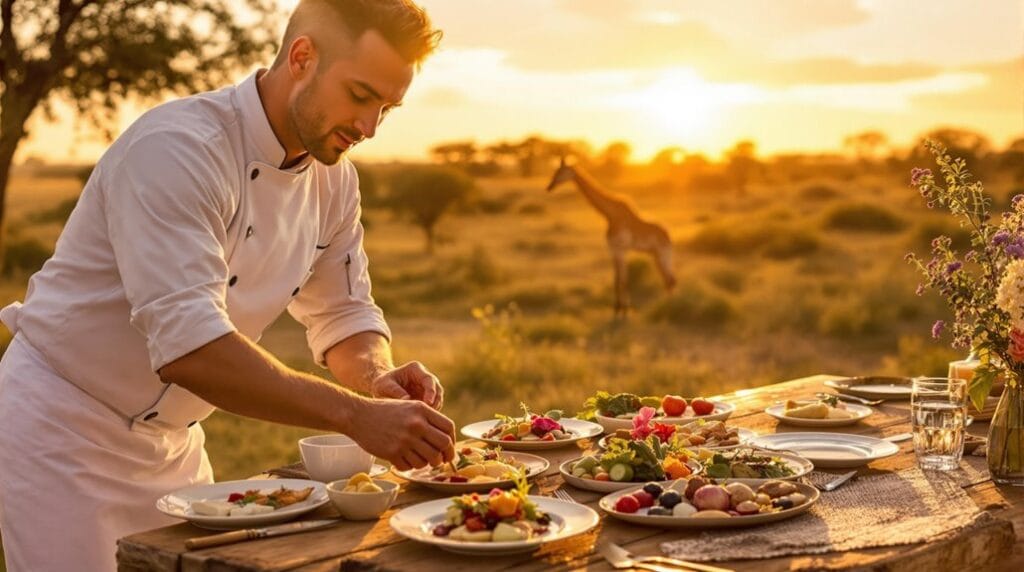You might not realize that indigenous instruments account for 80% of Africa's musical heritage, a fact that highlights the continent's rich tapestry of cultural expression. Each instrument, from the mbira to the djembe, plays an essential role in storytelling and community identity, weaving together histories that often go unnoticed. As you consider how these instruments adapt to modern influences, it raises questions about their future and significance today. What happens when traditional sounds intersect with contemporary music? The journey through Africa's musical landscape is just beginning to unfold.
Key Takeaways
- Indigenous instruments like mbira, djembe, and kora reflect Africa's diverse musical heritage, showcasing rich cultural traditions and craftsmanship.
- Instruments serve vital roles in ceremonies, storytelling, and community bonding, embodying spiritual beliefs and cultural narratives.
- Regional variations highlight unique musical identities, with distinct instruments and rhythms fostering communal celebrations across Africa.
- Preservation efforts, including oral transmission and digital archiving, aim to safeguard traditional music for future generations amid globalization threats.
- Fusion trends merge indigenous instruments with modern genres, enriching global music while celebrating African cultural identity and heritage.
Overview of Indigenous Instruments
What makes indigenous instruments in Africa so enchanting? These remarkable creations, like the mbira, djembe, kora, balafon, and ngoni, are more than just musical tools; they embody the rich tapestry of regional heritage and craftsmanship.
Each instrument reflects the unique culture of its area, often crafted from natural materials such as wood and animal skins, showcasing the artisans' intricate designs and dedication.
In traditional African music, these indigenous instruments play essential cultural functions, accompanying rituals, storytelling, and communal celebrations. Their rhythmic patterns and tonal qualities often mimic speech, allowing musicians to communicate emotions and narratives that resonate deeply within communities.
You can feel the energy in every beat of the djembe or the soothing melodies of the kora, uniting people in shared experiences.
Whether played solo or in large ensembles, these percussion instruments emphasize the communal aspect of music-making, pulling you into a vibrant world where sound fosters connection.
Engaging with these indigenous instruments means embracing a culture that values communication through music, creating a sense of belonging that transcends time and place.
Significance in Cultural Practices
Indigenous instruments in Africa hold profound significance in cultural practices, acting as essential conduits for communication and expression during important life events. When you participate in ceremonies like births, marriages, or funerals, you'll notice how traditional instruments like drums, xylophones, and mbira resonate with the community's collective spirit. Each beat and note tells a story, connecting generations through a rich oral tradition.
These instruments are more than just tools; they embody the intricate designs and carvings that reflect the spiritual beliefs and cultural heritage of their makers. As you engage in storytelling, music transforms into a narrative structure, imparting moral and cultural teachings while reinforcing a sense of belonging.
Moreover, the spiritual significance of these traditional instruments can't be understated. In religious and healing practices, drumming and singing create a sacred space, facilitating a deeper connection with the divine.
During community events, the shared experience of music strengthens bonds, celebrating identity and heritage. Embracing these indigenous instruments allows you to participate in a vibrant tapestry of cultural practices, enriching your understanding of Africa's diverse musical heritage.
Types of Indigenous Instruments
When you explore the types of indigenous instruments in Africa, you'll find a striking variety that reflects the continent's rich cultural tapestry.
From the rhythmic pulse of the djembe to the melodic strings of the kora, each instrument carries its own story and significance within community rituals and celebrations.
Understanding these categories not only enhances your appreciation of their unique sounds but also reveals how they connect people to their heritage.
Instrument Categories Overview
Across Africa, the rich tapestry of indigenous music is woven together by various types of instruments, each offering a unique sound and cultural significance. These instruments can be categorized into five main types: idiophones, chordophones, aerophones, membranophones, and melodic idiophones.
Idiophones are self-sounding and include vibrant instruments like slit drums, which are carved from wood and played by striking their edges. Chordophones, such as the kora—a 21-stringed harp-lute—combine string and percussion elements, often accompanying storytelling or cultural ceremonies.
Melodic idiophones, like the mbira, with its staggered metal tines, deliver complex melodies and rhythms pivotal to Zimbabwean music. Aerophones, or wind instruments, create sound through air movement, adding depth and breath to the music.
Membranophones, including the versatile djembe, are skin-covered drums played with bare hands, producing a wide range of tones that resonate with communal spirit.
Together, these categories of indigenous instruments not only define the diverse soundscapes of Africa but also reflect the interconnectedness of culture, community, and musical expression. Each instrument invites you to explore the rhythms of life that unite us all.
Cultural Significance of Instruments
The cultural significance of Africa's indigenous instruments extends far beyond their musical capabilities; they embody stories, traditions, and communal identities. Instruments like the mbira, djembe, and kora are integral to cultural celebrations, serving as the heartbeat of festivals and ceremonies throughout the continent.
Traditional drums, particularly the djembe and talking drums, communicate messages and signal important social changes during communal events, effectively linking generations and fostering unity.
String instruments such as the kora and ngoni aren't just for melodies; they're symbols of cultural identity and storytelling, weaving the rich narratives of their communities into each note. The artistic design of these instruments showcases intricate carvings and embellishments that reflect cultural beliefs and artistic expression, making them more than mere tools—they're cherished artifacts.
Crafted from locally sourced materials, instruments like the balafon and slit drums illustrate the deep connection between music, environment, and cultural practices. Each strum and beat resonates with the spirit of the land, a reflection of the enduring legacy of Africa's indigenous instruments and the vibrant cultures they represent.
Embracing these traditions helps you feel a sense of belonging to a rich, collective heritage.
Regional Variations Across Africa
Exploring the rich tapestry of indigenous instruments across Africa reveals a fascinating interplay of culture, geography, and history that shapes each region's unique musical landscape.
In West Africa, you'll find the kora, a stunning 21-string harp-lute, deeply woven into traditional music, while the djembe, a goblet drum, pulses at the heart of communal celebrations. These instruments not only provide rhythm but also foster a sense of belonging among communities.
Traveling south, the mbira, or thumb piano, resonates with the Shona people of Zimbabwe. Its intricate melodies and unique plucking technique embody Southern Africa's rich cultural heritage, often serving as a bridge between the living and the spiritual world.
In East Africa, the nyatiti captivates with its seven strings, played by the Luo people, showcasing a distinct stringed tradition that speaks to the region's identity.
Lastly, North Africa introduces the oud, a pear-shaped stringed instrument that enriches Arabic-influenced music in countries like Morocco and Algeria.
Each of these regional variations reflects the diverse musical traditions that unite African communities while celebrating their unique histories and cultural practices.
Influences on Contemporary Music
You'll notice how traditional rhythmic patterns from indigenous African music create a vibrant foundation for contemporary genres.
This fusion highlights the adaptability of instruments like the djembe and kora, enriching modern sounds while preserving cultural essence.
As artists blend these elements, they not only enhance their music but also foster a deeper appreciation for Africa's rich musical heritage.
Traditional Rhythmic Patterns
Traditional rhythmic patterns in Africa serve as a vibrant foundation for contemporary music, infusing genres like Afropop and hip hop with their intricate polyrhythms and syncopation. You'll notice how these complex polyrhythms, characterized by interlocking rhythms played simultaneously, create a rich tapestry that modern music often draws from.
Traditional drumming styles, such as those using the djembe and talking drums, emphasize varied accents and syncopation, shaping the rhythmic backbone of global music trends.
Engaging call-and-response techniques, intrinsic to African music, foster lively interactions that contemporary artists now embrace, enhancing audience participation in performances. As you listen, you'll hear how many musicians incorporate traditional rhythmic motifs, like the 6/8 or 12/8 time signatures, into their compositions. This blending not only honors the roots of African music but also enriches the contemporary genres you love.
Moreover, the emphasis on improvisation found in traditional African music inspires today's drummers and percussionists to explore diverse patterns, adding depth and dynamism to modern tracks.
This connection between past and present not only celebrates cultural heritage but also invites you to feel part of a global musical community.
Instrumental Fusion Trends
Indigenous instruments play a pivotal role in shaping the soundscape of contemporary African music, breathing new life into genres that blend tradition with modernity. You'll find that artists are increasingly incorporating instruments like the kora, mbira, and djembe, merging them with Western genres such as jazz, hip hop, and rock. This fusion creates innovative sounds that resonate deeply with diverse audiences.
Afropop stands at the forefront of this movement, marrying traditional rhythms with modern electronic production techniques. Pioneers like Fela Kuti have demonstrated the versatility of indigenous instruments through Afrobeat, a genre that combines traditional African music with jazz and funk. These artists not only celebrate their roots but also push the boundaries of contemporary music.
Collaborative projects, exemplified by Paul Simon's "Graceland," showcase cultural exchange, bringing indigenous instruments into the global spotlight. Festivals like Visa for Music further advocate for this fusion, providing platforms for artists to reach wider audiences.
Preservation of Musical Traditions
The vibrant tapestry of African musical traditions thrives on the strength of oral transmission, where the rich sounds and intricate rhythms are passed down through generations. This method guarantees that the cultural context remains intact, allowing traditional musicians to keep their heritage alive. However, the preservation of these traditions faces modern challenges.
| Preservation Method | Description | Impact on Traditions |
|---|---|---|
| Oral Transmission | Knowledge shared through storytelling and performance | Maintains authenticity and cultural integrity |
| Recording and Archiving | Audio and video documentation of performances | Safeguards music for future generations |
| Digital Initiatives | Online archives and platforms for broader access | Links global audiences to African music |
Collaboration with local communities is essential for nurturing these musical practices, guaranteeing that the unique voices of each culture are respected. Additionally, post-colonial revival movements are crucial for blending traditional sounds with contemporary influences, creating new styles that resonate with today's audiences. By engaging with these efforts, you help foster a sense of belonging and appreciation for Africa's rich musical heritage. Together, we can guarantee that these traditions continue to inspire generations to come.
Musical Instruments and Identity
Across the diverse landscapes of Africa, musical instruments serve as essential expressions of cultural identity and heritage, weaving together the threads of community and tradition. Instruments like the mbira, kora, and djembe aren't just tools for music—they're crucial to social events and rituals, reinforcing communal ties that bind people together.
Each indigenous instrument is crafted with care, showcasing intricate designs that reflect the cultural symbols and artistic traditions of the artisans who create them.
As you explore the melodies produced by the balafon or the ngoni, you'll find that they do more than entertain; they tell stories and convey historical narratives that enrich your understanding of identity. This storytelling aspect embeds a sense of belonging, allowing you to connect deeply with the past and present of your community.
The craftsmanship involved in making these instruments is a cherished legacy, passed down through generations, ensuring that cultural identity and musical heritage remain vibrant even in contemporary contexts. In this way, indigenous instruments become more than mere artifacts; they embody the spirit of a people, celebrating their uniqueness and resilience through music.
Future of Indigenous Instruments
As globalization reshapes the musical landscape, the future of Africa's indigenous instruments hangs in a delicate balance. The rise of digital music threatens to overshadow traditional practices, potentially leading to a decline in the use of these culturally significant instruments.
However, there's hope. Educational programs and workshops are actively teaching younger generations about the art of traditional music-making, connecting them to their rich heritage.
You'll find that the increasing interest in world music fosters cultural exchange, allowing contemporary artists to collaborate with traditional musicians. This fusion not only revitalizes the use of indigenous instruments in modern music but also enhances their relevance in today's soundscape.
Organizations and festivals dedicated to African music are champions of this preservation, providing essential platforms for artists to showcase their unique artistry.
Moreover, technology plays an important role in this journey. Digital archiving and online platforms empower you to explore and share indigenous sounds, ensuring they remain accessible for future generations.
Frequently Asked Questions
What Are the Indigenous Musical Instruments of Africa?
When you explore Africa's indigenous musical instruments, you'll uncover a tapestry of traditional rhythms and cultural significance.
Each instrument showcases unique craftsmanship, reflecting regional variations and historical evolution. Instruments like the djembe and kora play crucial roles in musical storytelling, often accompanying dance at community gatherings.
These sounds foster spiritual connections, making music an integral part of life's celebrations and rituals. You'll find that every note carries the weight of history and belonging.
What Are the Indigenous Musical Instruments?
Did you know that over 1,000 indigenous musical instruments exist worldwide? Each reflects traditional craftsmanship and cultural significance.
You'll find regional variations in instrument construction, like the djembe's rhythmic patterns or the kora's melodic scales.
These instruments play essential roles in performance contexts, from community gatherings to musical storytelling, connecting people through shared experiences.
Embracing these unique sounds fosters a sense of belonging and appreciation for diverse musical traditions across the globe.
What Is the Most Important Instrument in African Culture?
You might find that the djembe stands out as an essential instrument in African culture, embodying cultural significance through its rhythmic patterns and community bonding.
Used in traditional ceremonies, it fosters spiritual connections and musical storytelling across regional variations.
Its creation involves intricate instrument-making techniques passed down through generations, ensuring generational transmission of knowledge.
When you hear its beats, you tap into the essence of community, celebrating heritage and shared experiences that unite people.
What Are the Four Main Types of African Musical Instruments?
You'll discover four main types of African musical instruments: idiophones, chordophones, aerophones, and membranophones. Each classification showcases traditional rhythms and cultural significance, reflecting regional variations and performance contexts.
Through craftsmanship techniques, artisans create instruments that embody sound symbolism, enriching musical storytelling. As you explore these categories, you'll appreciate their historical evolution and how they connect communities, fostering a sense of belonging and shared heritage in Africa's vibrant musical landscape.
Conclusion
In the grand symphony of Africa's cultural tapestry, indigenous instruments aren't just relics; they're the heartbeat of generations, pulsating with stories and spirit. Their vibrant sounds echo through time, shaping identities and weaving connections that defy distance. As you embrace these extraordinary instruments, you're not merely listening—you're stepping into a world where history dances and communities unite. The future of these musical treasures is bright, promising an everlasting legacy that will resonate for eons to come.







